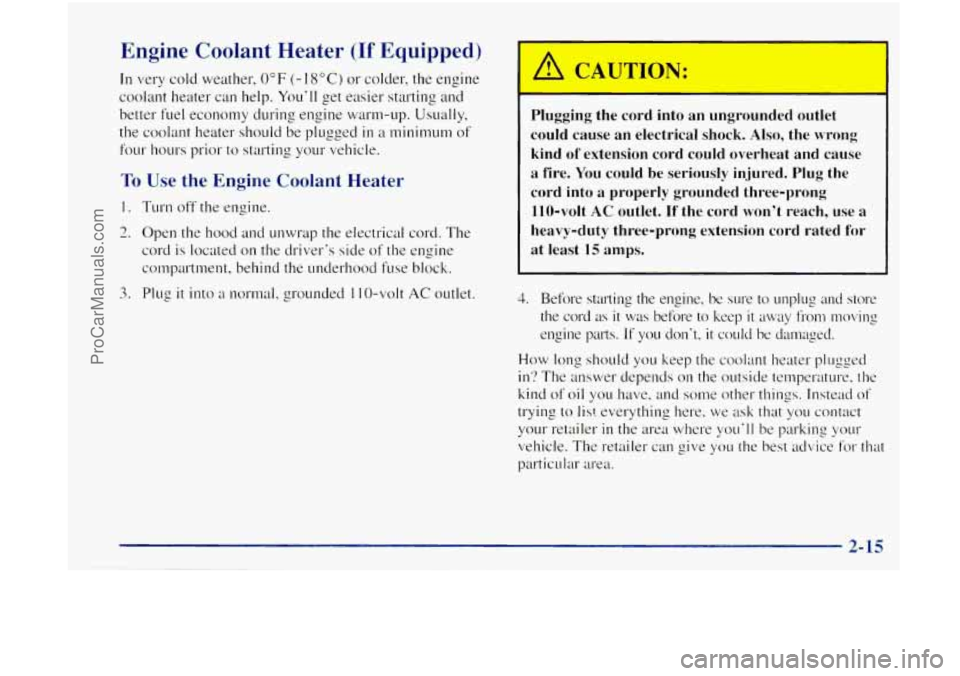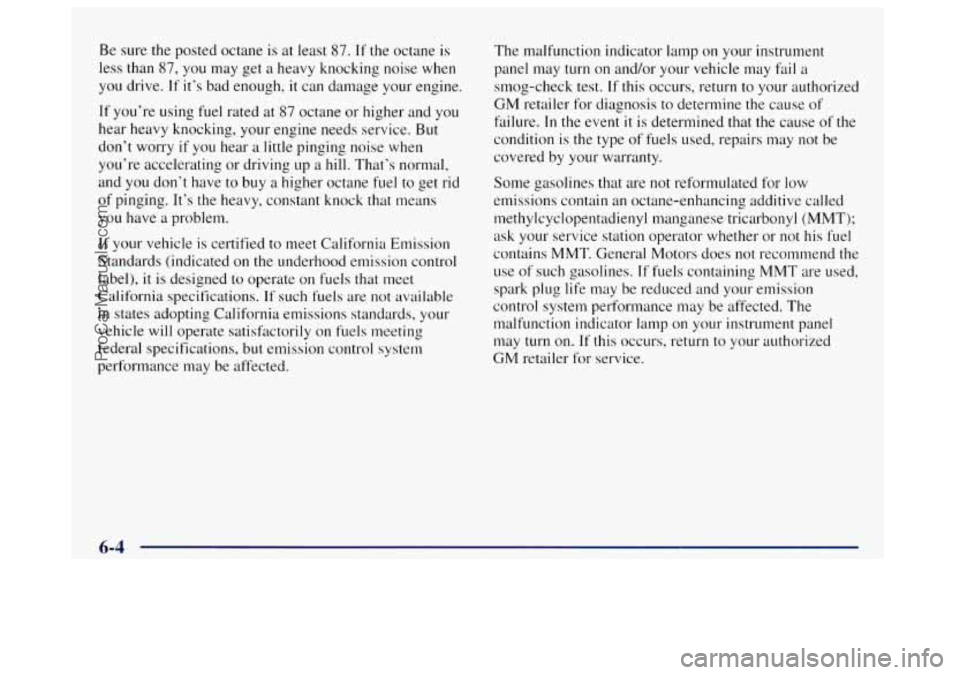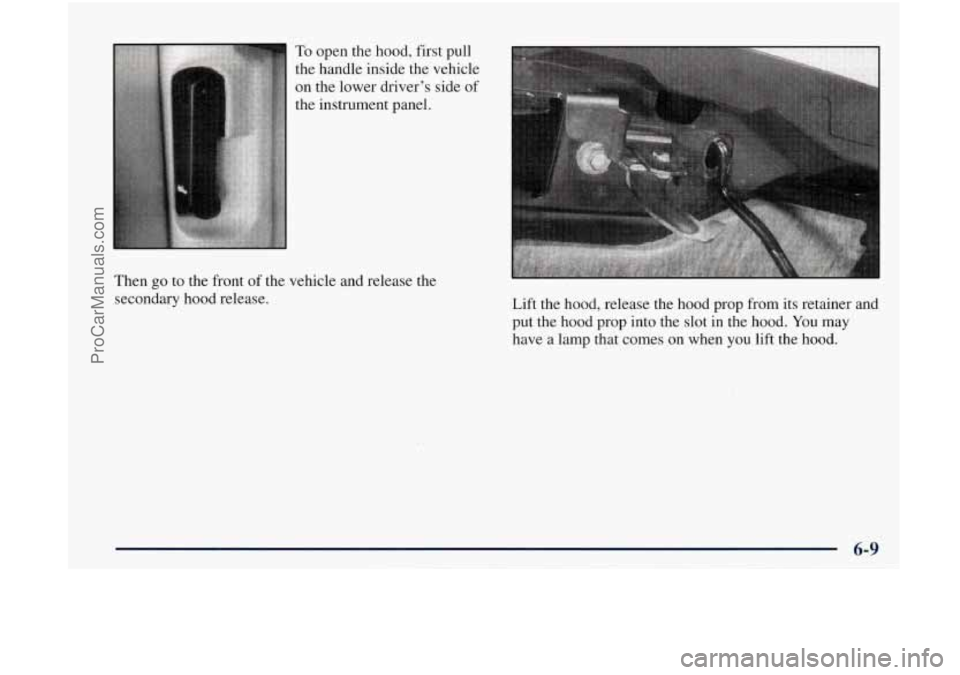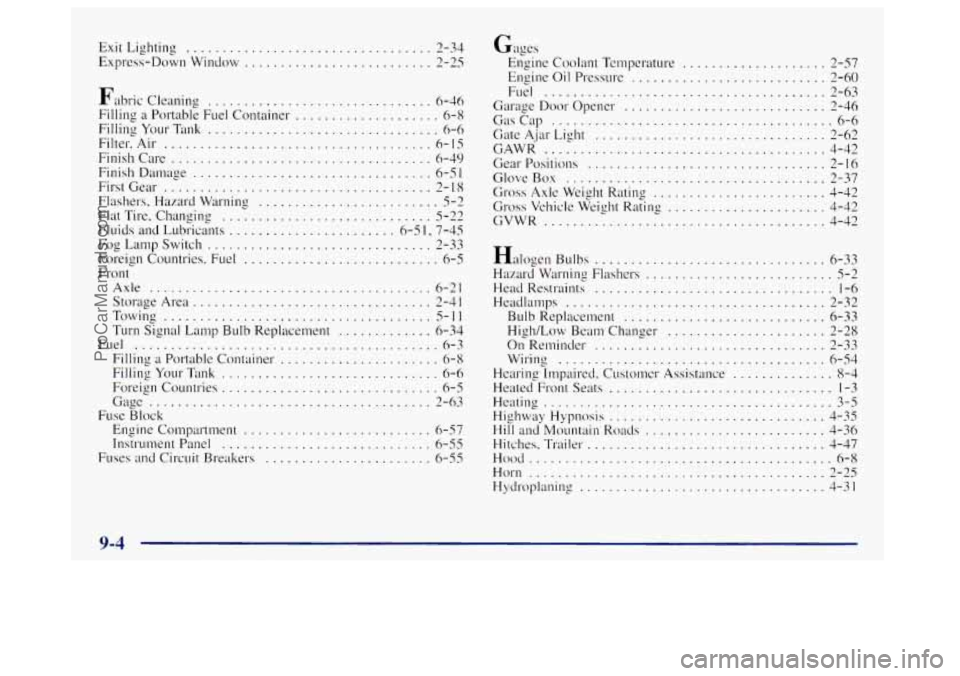hood open OLDSMOBILE BRAVADA 1998 Owners Manual
[x] Cancel search | Manufacturer: OLDSMOBILE, Model Year: 1998, Model line: BRAVADA, Model: OLDSMOBILE BRAVADA 1998Pages: 380, PDF Size: 19.2 MB
Page 79 of 380

Engine Coolant Heater (If Equipped)
In very cold weather, 0°F (-18°C) or colder, the engine
coolant heater can help.
You’ll get easier starting and
better fuel economy during engine warm-up. Usually,
the coolant heater should be plugged
in a minimum of
four hours prior to starting your vehicle.
To Use the Engine Coolant Heater
1. Turn off the engine.
2. Open the hood and unwrap the electrical cord. The
cord is located
on the driver’s side of the engine
compartment, behind the underhood fuse block.
3. Plug it into a normal, grounded 1 10-volt AC outlet.
Plugging the cord into an ungrounded outlet
could cause an electrical shock.
Also, the wrong
kind
of extension cord could overheat and cause
a fire. You could be seriously injured. Plug the
cord into
a properly grounded three-prong
110-volt
AC outlet. If the cord won’t reach, use a
heavy-duty three-prong extension cord rated
for
at least 15 amps.
4. Before starting the engine, be sure to unplug and store
the cord as it was before to keep it away from moving
engine parts.
If you don’t, it could be damaged.
How
long should you keep the coolant heater plugged
in?
The answer depends on the outside temperature, the
kind
of oil you have, and some other things. Instead of
trying to list everything here. we ask that you contact
your retailer
in the area where you’ll be parking your
vehicle. The retailer can give
yo11 the best advice for that
particular area.
ProCarManuals.com
Page 211 of 380

4. Open both hoods and locate the batteries. Find
the positive
(+) and negative (-) terminals on
each battery.
/A CAUTION:
Using a match near a battery can cause battery
gas to explode. People have been hurt doing this,
and some have been blinded. Use a flashlight if
you need more light.
Be sure the battery has enough water. You don’t
need to add water to the Delco Freedom@ battery
installed in every new
GM vehicle. But if a
battery has filler caps, be sure the right amount
of fluid is there. If it is low, add water to take care
of that first. If you don’t, explosive gas could
be present.
Battery fluid contains acid that can burn you.
Don’t get it on you.
If you accidentally get it in
your eyes or on your skin, flush the place with
water and get medical help immediately.
5. Check that the jumper cables don’t have loose or
missing insulation. If they do, you could get a shock.
The vehicles could be damaged too.
Before you connect the cables, here are some basic
things you should know. Positive
(+) will go to
positive (+) and negative (-) will go to an unpainted
metal engine part or
a body metal surface. Don’t
connect positive
(+) to negative (-) or you’ll get a
short that would damage the battery and maybe other
parts too. And don’t connect the negative
(-) to
negative
(-).
6. Connect the red positive
(+) cable to the positive
(+) terminal of the
vehicle with the
dead battery.
5-5
ProCarManuals.com
Page 219 of 380

Engine Overheating
You will find a coolant temperature gage on your
vehicle's instrument panel. See "Gages" in the Index.
1 [f Steam Is Coming From Your Engine
Steam from an overheated engine can burn you
badly, even if you just open the hood. Stay away
from the engine if you see or hear steam coming
from it. Just turn it off and get everyone away
from the vehicle until it
cools down. Wait until
there is no sign
of steam or coolant before you
open the hood.
If you keep driving when your engine is
overheated, the liquids in it can catch fire.
You or
others could be badly burned. Stop your engine if
it overheats, and get out of the vehicle until the
engine is
cool.
I NOTICE: I
If your engine catches fire because you keep
driving with no coolant, your vehicle can be
badly damaged. The costly repairs would not be
covered
by your warranty.
5-13
ProCarManuals.com
Page 220 of 380

If No Steam Is Coming From Your Engine
If you get the overheat warning but see or hear no
steam,
the problem may not be too serious. Sometimes
the engine can get a little too hot when you:
0 Climb a long hill on a hot day.
0 Stop after high-speed driving.
0 Idle for long periods in traffic.
0 Tow a trailer.
If you get the overheat warning with no sign of steam,
try this for a minute or
so:
1. Turn off your air conditioner.
2. Turn on your heater to full hot at the highest fan
speed and open the window as necessary.
3. If you’re in a traffic jam, shift to NEUTRAL (N);
otherwise, shift to the highest gear while
driving
-- DRIVE (D) or THIRD (3).
If you no longer have the overheat warning, you
can drive. Just to be safe, drive slower for about
10 minutes. If the warning doesn’t come back on,
you can drive normally.
If the warning continues, pull over, stop, and park your
vehicle right away.
If there’s still no sign
of steam, push the accelerator until
the engine speed is about twice as fast as normal idle
speed. Bring the engine speed back to normal idle speed
after two or three minutes. Now see if the warning stops.
But then, if you still have the warning, turn oflthe
engine
and get evrryone out of the vehicle until it
cools down.
You may decide not to lift the hood but to get service
help right away.
5-14
ProCarManuals.com
Page 246 of 380

Be sure the posted octane is at least 87. If the octane is
less than 87, you may get a heavy knocking noise when
you drive.
If it’s bad enough, it can damage your engine.
If you’re using fuel rated at 87 octane or higher and you
hear heavy knocking, your engine needs service. But
don’t worry
if you hear a little pinging noise when
you’re accelerating or driving up
a hill. That’s normal,
and
you don’t have to buy a higher octane fuel to get rid
of pinging. It’s the heavy, constant knock that means
you have a problem.
If your vehicle is certified to meet California Emission
Standards (indicated on the underhood emission control
label), it is designed to operate on fuels that meet
California specifications.
If such fuels are not available
in states adopting California emissions standards, your
vehicle
will operate satisfactorily on fuels meeting
federal specifications, but emission control system
performance may be affected. The malfunction indicator lamp
on your instrument
panel may turn on and/or your vehicle may fail a
smog-check test.
If this occurs, return to your authorized
GM retailer for diagnosis to determine the cause
of
failure. In the event it is determined that the cause of the
condition
is the type of fuels used, repairs may not be
covered by your warranty.
Some gasolines that are not reformulated for
low
emissions contain an octane-enhancing additive called
tnethylcyclopentadienyl manganese tricarbonyl (MMT);
ask your service station operator whether or not
his fuel
contains MMT. General Motors does not recommend the
use of such gasolines.
If fuels containing MMT are used,
spark plug life may be reduced and your emission
control system performance may be affected. The
malfunction indicator lamp on your instrument panel
may turn on.
If this occurs, return to your authorized
GM retailer for service.
6-4
ProCarManuals.com
Page 250 of 380

Filling a Portable Fuel Container Checking Things
Under the Hood
Never fill a portable fuel container while it is in
your vehicle. Static electricity discharge from the
container can ignite the gasoline vapor. You can
be badly burned and your vehicle damaged if this
occurs. To help avoid injury to you and others:
Dispense gasoline only into approved
containers.
Do not fill a container while it is inside a
vehicle, in a vehicle’s trunk, pickup bed or
on any surface other than the ground.
inside of the fill opening before operating
the nozzle. Contact should be maintained
until the filling
is complete.
Bring the fill nozzle in contact with the
Don’t smoke while pumping gasoline. Things that burn can
get on hot engine parts and
start
a fire. These include liquids like gasoline,
oil, coolant, brake fluid, windshield washer and
other fluids, and plastic or rubber. You or others
could be burned. Be careful not to drop or spill
things that
will burn onto a hot engine.
6-8
ProCarManuals.com
Page 251 of 380

To open the hood, first pull
the handle inside the vehicle
on the lower driver’s side of
the instrument panel.
Then
go to the front of the vehicle and release the
secondary hood release. Lift the hood, release the hood prop from its retainer and
put the hood prop into the slot in the hood.
You may
have a lamp that comes on when you lift the hood.
6-9
ProCarManuals.com
Page 275 of 380

Vehicle Storage Halogen Bulbs
If you’re not going to drive your vehicle for 25 days or
more, remove the black, negative
(-) cable from the
battery. This
will help keep your battery from
running down.
CAUTION:
Batteries have acid that can burn you and gas
that can explode. You can be badly hurt if you
aren’t careful. See “Jump Starting” in the Index Halogen
bulbs have pressurized gas inside and
can burst
if you drop or scratch the bulb. You or
others could be injured. Be sure to read and
follow the instructions on the bulb package.
Composite Headlamps
for tips on working around a battery without
getting hurt. 1. Open the hood.
2. Remove the black retainer clips by lifting up.
I I
3. Pull the headlamp assembly out.
Contact your retailer to learn how to prepare your
vehicle for longer storage periods.
Also, for your audio system, see ”Theft-Deterrent
Feature”
in the Index.
Bulb Replacement
Before you replace any bulbs, be sure that all the lamps
are off and the engine isn’t running. See ”Replacement
Bulbs”
in the index for the proper type of bulb to use.
4. Unplug the electrical connector.
5. Turn the bulb assembly to the left to remove it.
6. Put the new bulb assembly into the headlamp
assembly and turn
it to the right until it is tight.
1. P~LI~ in the electrical connector.
8. Put the headlamp lens assembly back into the
vehicle. Install the two retaining clips.
ProCarManuals.com
Page 344 of 380

At Least Twice a Year At Least Once a Year
Restraint System Check
Make sure the safety belt reminder light and all your
belts, buckles, latch plates, retractors and anchorages are
working properly. Look for any other
loose or damaged
safety belt system parts.
If you see anything that might
keep
a safety belt system from doing its job, have it
repaired. Have any torn or frayed safety belts replaced.
Also look for any opened or broken air bag coverings,
and have them repaired or replaced. (The air bag system
does not need regular maintenance.)
Wiper Blade Check
Inspect wiper blades for wear or cracking. Replace blade
inserts that appear worn or damaged or that streak or
miss areas of the windshield. Also see “Wiper Blades,
Cleaning”
in the Index.
Automatic Transmission Check
Check the transmission fluid level; add if needed. See
“Automatic Transmission”
in the Index. A fluid loss
may indicate
a problem. Check the system and repair
if needed.
Key Lock Cylinders Service
Lubricate the key lock cylinders with the lubricant
specified
in Part D.
Body Lubrication Service
Lubricate all body door and fuel door hinges, rear
compartment hinges, latches and locks including the
glove box, console doors and the body hood and any
moving seat hardware. Lubricate the hood safety lever
pivot and prop rod pivot. Part
D tells you what to use.
More frequent lubrication may be required when
exposed to
a corrosive environment.
ProCarManuals.com
Page 368 of 380

Exit Lighting .................................. 2-34
Express-Down Window
.......................... 2-25
Fabric Cleaning
............................... 6-46
Filling a Portable Fuel Container
.................... 6-8
Filling Your
Tank ................................ 6-6
Filter.
Air ..................................... 6-15
Finish Care
.................................... 6-49
Finish Damage
................................. 6-5 I
FirstGear ..................................... 2-18
Flashers. Hazard Warning
......................... 5-2
Flat Tire. Changing
............................. 5-22
Fluids and Lubricants
....................... 6-51. 7-45
FogLampSwitch
............................... 2-33
Foreign Countries. Fuel
........................... 6-5
Front
Axle ....................................... 6-21
Towing
..................................... 5-11
Turn Signal Lamp Bulb Replacement ............. 6-34
Fuel
.......................................... 6-3
Filling a Portable Container ...................... 6-8
Storage
Area
................................. 2-41
Filling Your Tank
.............................. 6-6
Foreign Countries
.............................. 6-5
Gage
....................................... 2-63
Engine Compartment .......................... 6-57
Instrument Panel
............................. 6-55
Fuses and Circuit Breakers ....................... 6-55
Fuse Block Gages
Engine Coolant Temperature
.................... 2-57
Engine Oil Pressure
........................... 2-60
Garage Door Opener
............................ 2-46
GasCap ....................................... 6-6
Gate
A-jar Light ................................ 2-62
GAWR
....................................... 4-42
Gear Positions
................................. 2-16
GloveBox
.................................... 2-37
Gross Axle Weight Rating
........................ 4-42
Gross Vehicle Weight Ratlng
...................... 4-42
Fuel
....................................... 2-63
GVWR
....................................... 4-42
Halogen Bulbs
................................ 6-33
Hazard Warning Flashers
.......................... 5-2
Bulb Replacement
............................ 6-33
High/Low Beam Changer
...................... 2-28
On Reminder
................................ 2-33
Wiring
..................................... 6-54
Hearing Impaired. Customer Assistance
.............. 8-4
Heated Front Seats ............................... 1-3
Heating ........................................ 3-5
Highway Hypnosis .............................. 4-35
Hill and Mountain
Roads ......................... 4-36
Hitches. Trailer
................................. 4-47
Hood .......................................... 6-8
Hydroplaning
.................................. 4-31
Head
Restraints ................................. 1-6
Headlamps
.................................... 2-32
Horn
......................................... 2-25
9-4
ProCarManuals.com